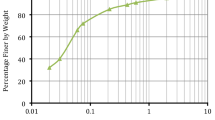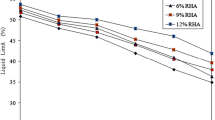Abstract
The current study analyzed a total of 28 flexible pavement sections for evaluating influence of cementitious stabilization of soil on pavement distresses under different climate, traffic, and reliability level conditions. A total of three stabilizers, namely, 3% lime, 15% class C fly ash (CFA) and 15% cement kiln dust (CKD) were selected. A total of six types of pavement distresses namely, total rutting, asphalt concrete (AC) rutting, AC bottom-up cracking, AC top-down cracking, AC thermal cracking and international roughness index (IRI) values were predicted for a period of 20 years (240 months) using AASHTOWare pavement mechanistic-empirical (ME) design software. It was found that cementitious stabilization is effective in reducing only total rutting, bottom-up cracking and IRI under different climate, traffic, and reliability levels. The amount of improvement was found dependent on resilient modulus values of stabilized soil layer. However, no effect of cementitious stabilization of subgrade soil was noticed on top-down cracking and thermal cracking of AC layer. On the contrary, cementitious stabilization increased AC rutting of pavement. The maximum percent increase in AC rutting was found 6.4% for CKD stabilization in WY climate, 5.5% for CKD stabilization under 1000 and 5000 traffic levels, and 5.6% for CKD stabilization at a reliability level of 80%. Among all six distresses, stabilization was found most effective in reducing bottom-up cracking (or fatigue cracking) of AC layer under different climate, traffic, and reliability level conditions. Further, the level of improvement in bottom-up cracking due to stabilization was found most effective under warmer climate region and highest reliability level. Specifically, the maximum percent improvement in bottom-up cracking was noticed 61.3% for CKD stabilization in TX climate, 70.5% for CKD stabilization under 10,000 traffic level, and 92.9% at a reliability level of 95%. The cementitious stabilization of subgrade soil showed highest percent improvement in reducing IRI values under coldest temperatures (1.8% for CKD stabilization in WY climate), highest traffic level (1.8% for CKD stabilization under 10,000 traffic level), and lowest reliability levels (1.1–1.5% at a reliability level of 80%).














Similar content being viewed by others
Data availability
Data generated or analyzed during the study are available from the corresponding author by request.
Abbreviations
- AADTT:
-
Annual average daily truck traffic
- AC:
-
Asphalt concrete
- BUC:
-
Bottom-up cracking
- CBR:
-
California bearing ratio
- CFA:
-
Class C fly ash
- CKD:
-
Cement kiln dust
- IL:
-
Illinois
- IRI:
-
International roughness index
- ME:
-
Mechanistic empirical
- Mr:
-
Resilient modulus
- PET:
-
Polyethylene terephthalate
- PG:
-
Performance grade
- RAP:
-
Recycled asphalt pavement
- TC:
-
Thermal cracking
- TDC:
-
Top-down cracking
- TX:
-
Texas
- WY:
-
Wyoming
- ν:
-
Poisson’s ratio
References
TRIP (2021), https://tripnet.org/wp-content/uploads/2020/04/TRIP_Fact_Sheet_NATL.pdf
US Department of Transportation (2023), Federal Highway Administration Publication and Statistics, https://www.fhwa.dot.gov/policyinformation/travel_monitoring/23septvt/23septvt.pdf
Edmunds, K., Juhasz, M., Ahammed, M.A. (2014), ‘Reliability Sensitivity of ME Design’, Experience with Pavement ME Design session of the 2014 Annual Conference of the Transportation Association of Canada, Montreal, Quebec. Retrieved from http://conf.tac-atc.ca/english/annualconference/tac2014/s-13/edmunds.pdf
Kim, S., Ceylan, H., Ma, Di., & Gopalakrishnan, K. (2014). Calibration of Pavement ME Design and Mechanistic-Empirical Pavement Design Guide Performance Prediction Models for Iowa Pavement Systems. Journal of Transportation Engineering ASCE, 140, 10.
Pierce, L. M., Ginger, M. 2014. Implementation of the AASHTO Mechanistic-Empirical Pavement Design Guide and Software. Washington, D.C: National Cooperative Highway Research Program.
Sadek, H. A., Masad, E. A., Sirin, O., Al-Khalid, H., Sadeq, M. A., & Little, D. (2014). Implementation of mechanistic-empirical pavement analysis in the State of Qatar. International Journal of Pavement Engineering, 15(6), 495–511. https://doi.org/10.1080/10298436.2013.837164
Hasan, M. A., & Tarefder, R. A. (2018). Development of temperature zone map for mechanistic empirical (ME) pavement design. International Journal of Pavement Research and Technology, 11, 99–111.
Hasan, M. M., Rahman, A. S. M. A., & Tarefder, R. A. (2020). Investigation of accuracy of pavement mechanistic empirical prediction performance by incorporating Level 1 inputs. Journal of Traffic and Transportation Engineering (English Edition), 7(2), 259–268.
Jibon, M., Mishra, D., & Kassem, E. (2020). Laboratory Characterization of Fine-grained Soils for Pavement ME Design Implementation in Idho. Transportation Geotechnics, 25, 1–13.
Mu, F., Mack, J. W., & Rodden, R. A. (2018). Review of National and State-Level Calibrations of AASHTOWare Pavement ME Design for New Jointed Plain Concrete Pavement. International Journal of Pavement Engineering, 19(9), 825–883.
Francois, A (2017). "Evaluating the impact of different types of stabilized bases on the overall performance of flexible pavements". Theses and Dissertations. 2384. https://rdw.rowan.edu/etd/2384
Islam, S., Sufian, A. and Hossain, M. (2017). Effect of Treated Subgrade Layer on Mechanistic-Empirical Pavement Design, Proceedings of the 10th International Conference on the Bearing Capacity of Roads, Railways and Airfields (BCRRA 2017).
Souliman, M. I., GC, H., Isied, M. M., & Walubita, L. F. (2020). Treated versus Untreated Aggregate Bases for Flexible Pavements: Nationwide Comparative Case Study. Transportation Research Record, 2674(2), 225–236.
Qadir, A., Gazder, U., & Choudhary, K. U. N. (2021). Statistical analysis for comparing and predicting rutting resistance of asphalt pavements with rigid and flexible geogrid layers. Construction and Building Materials, 302, 124136.
Rabbah, S., Hattamleh, O. A., Aldeeky, H., & Alfoul, B. A. (2021). Effect of glass fiber on the properties of expansive soil and its utilization as subgrade reinforcement in pavement applications. Case Studies in Construction Materials, 14, 1–12.
Yaghoubi, E., Yaghoubi, M., Guerrieri, M., & Sudarsanan, N. (2021). Improving expansive clay subgrades using recycled glass: Resilient modulus characteristics and pavement performance. Construction and Building Materials, 302, 124384.
Banerji, A. K., Topdar, P., & Datta, A. (2022). Effect of Axle Overloading on Pavement Structural Behaviour with Improved Clayey Subgrade Using PET Fibres. Civil Engineering and Architecture, 10(6), 2410–2425.
Ghanizadeh, A. R., Salehi, M., & Jalali, F. (2022). Investigating the Effect of Lime Stabilization of Subgrade on the Fatigue and Rutting Lives of Flexible Pavements Using the Nonlinear Mechanistic-Empirical Analysis. Geotechnical and Geological Engineering, 41(2), 1287–1307. https://doi.org/10.1007/s10706-022-02336-x
Mohamedzein, Y., Hassan, H., & Al-Hashmi, K. (2022). Effect of cement-by-pass dust stabilized-expansive soil subgrade on pavement rutting. Innovative Infrastructure Solutions, 7(1), 63.
Shakhan, M. R., Topal, A., & Segoz, B. (2022). Impact of Subgrade Strength on Pavement Performance. Faculty of Engineering Journal of Science and Engineering, 24(71), 501–508.
Cardoso, J., Ferreira, A., Almeida, A., & Santos, J. (2023). Incorporation of plastic waste into road pavements: A systematic literature review on the fatigue and rutting performances. Construction and Building Materials, 407, 133441.
Rabab’ah, S. R., Sharo, A. A., Alqudah, M. M., Ashteyat, A. M., & Saleh, H. O. (2023). Effect of using Oil Shale Ash on geotechnical properties of cement-stabilized expansive soil for pavement application. Case Studies in Construction Materials, 19, e02508.
Malkawi, D. A., Rabab’ah, S. R., AlSyouf, M. M., & Aldeeky, H. (2023). Utilizing expansive soil treated with phosphogypsum and lime in pavement construction. Results in Engineering, 19, 101256.
Xiong, Y., & Wang, H. (2024). Analysis of the grouting fullness and road performance of hot-recycled semi-flexible pavement materials. Case Studies in Construction Materials, 20, e02755.
Zhang, Q., Yang, S., & Chen, G. (2024). Regional variations of climate change impacts on asphalt pavement rutting distress. Transportation Research Part D: Transport and Environment, 126, 103968.
Huang, Y. H. (2003). Pavement Analysis and Design. Prentice Hall.
Solanki, P., Zaman, M. M., & Dean, J. (2010). “Resilient Modulus of Clay Subgrades Stabilized with Lime, Class C Fly Ash, and Cement Kiln Dust for Pavement Design”, Transportation Research Record: Journal of the Transportation Research Board. No., 2186, 101–110.
Solanki, P. (2010). Characterization of Cementitiously Stabilized Subgrades for Mechanistic-Empirical Pavement Design, Ph.D. Dissertation, University of Oklahoma, Norman, OK, USA.
Jones, M. P., & Witczak, M. W. (1977). Subgrade modulus on the san diego test road. Transportation Research Record: Journal of the Transportation Research Board, 641, pp. 1–6.
Ping, W. V., Y. Zenghai, Chunshui, L., & Bruce, D. (2001). Measuring resilient modulus of granular materials in flexible pavements. Transportation Research Record: Journal of the Transportation Research Board, 1778, pp. 81–90
Wen, H., Muhunthan, B., Edil, T., & Tinjum, J. M. (2014). “Characterization of Cementitiously Stabilizerd Layers for Use in Pavement Desing and Analysis,” Project 04–36, Final Report No. 789, National Cooperative Highway Research Program (NCHRP), Washington, DC.
Meng, S., Hu, L., Wei, D., & Li, Y. (2004) The Performance of Stabilized Base Pavements under Accelerated Loading. In the Proceedings of 2004 Accelerated Pavement Testing International Conference, Minneapolis, MN.
Acknowledgements
The authors would like to acknowledge graduate students, namely, Tejaswi Reddy and Harsh Chauhan, for assisting with the analysis and literature review.
Funding
Not applicable.
Author information
Authors and Affiliations
Contributions
The authors confirm contribution to the paper as follows: study conception and design: Pranshoo Solanki; data collection: Pranshoo Solanki, Juan Lopez; analysis and interpretation of results: Pranshoo Solanki, Juan Lopez; draft manuscript preparation: Pranshoo Solanki. All authors reviewed the results and approved the final version of the manuscript.
Corresponding author
Ethics declarations
Conflict of Interest
The authors declare that there is no conflict of interest regarding the publication of this paper.
Rights and permissions
Springer Nature or its licensor (e.g. a society or other partner) holds exclusive rights to this article under a publishing agreement with the author(s) or other rightsholder(s); author self-archiving of the accepted manuscript version of this article is solely governed by the terms of such publishing agreement and applicable law.
About this article
Cite this article
Solanki, P., Lopez, J.D. Influence of Cementitious Stabilization of Subgrade Soil on the Distresses of Flexible Pavement Sections. Int. J. Pavement Res. Technol. (2024). https://doi.org/10.1007/s42947-024-00441-z
Received:
Revised:
Accepted:
Published:
DOI: https://doi.org/10.1007/s42947-024-00441-z




